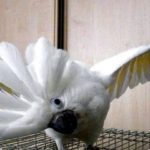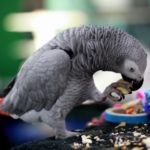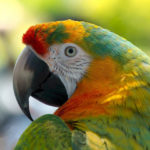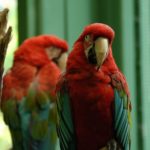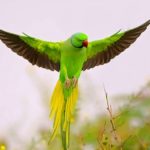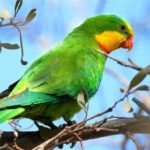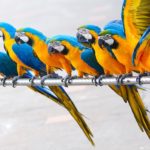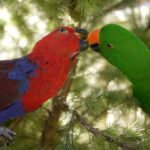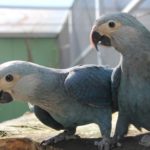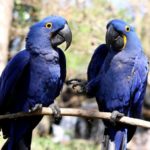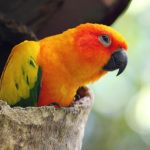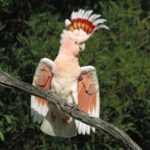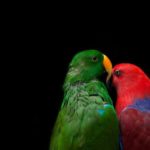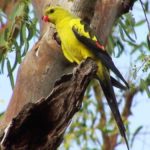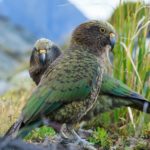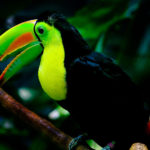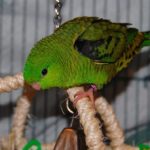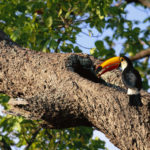Senegalese Parrot
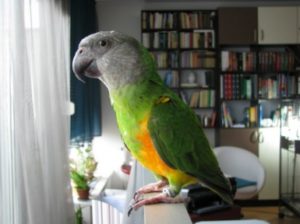 Senegalese parrot is a bright bird native to Africa. It lives in the jungle of Senegal, Nigeria, Cameroon, Chad. This type of parrot is small in size, about 20 cm long and weighs about 150 grams. The plumage of the body is bright green with orange sides, the head is gray, the beak is black.
Senegalese parrot is a bright bird native to Africa. It lives in the jungle of Senegal, Nigeria, Cameroon, Chad. This type of parrot is small in size, about 20 cm long and weighs about 150 grams. The plumage of the body is bright green with orange sides, the head is gray, the beak is black.
Senegalese parrot refers to talking parrots, can memorize about 20 words and short phrases. Not pretentious to the conditions of detention and feed.
Of the huge number of birds that inhabit Africa, parrots have been of particular interest to humans for a long time. One of these is the Senegalese parrot. People have long kept these beautiful and quick-witted birds at home, primarily because they have an amazing ability to reproduce human speech.
They are very quick-witted, easy to train, real “geeks.” Senegalese parrots grown at home are very attached to their master. And considering that the life expectancy of parrots is compatible with the life expectancy of a person, they often become full members of families, some of them sometimes live up to 50 years. They are Senegalese because for the first time they were brought to Europe just from Senegal. In general, these birds inhabit a significant territory of Africa, all its western and southwestern parts.
Senegalese parrots are not the largest. The length of the body is 2–25 cm, and the length of the tail is 10 cm. The legs are pink with green “panties”. The tail, wings and upper body are green, the lower abdomen is yellow or orange with a wedge-shaped triangle of green color. Up to a year, their abdomen is lemon yellow. The head is dark gray with a large blackish-gray beak.
In females, the plumage of the head is lighter and the beak is smaller. In young parrots the color of the iris is dark red, and in adults it is yellow. Up to six months, the eyes of young individuals are black, ash gray cheeks and head color are dark gray. By color, there are three subspecies of Senegalese parrots: a long-winged parrot, its color is light green; Finch’s long-winged parrot is dark green with an orange abdomen and a Raichenov parrot with a greenish wedge on its chest to the very abdomen.
Under natural conditions, the Senegalese parrot lives in hollows of trees or their crowns. It feeds on flowers and fruits of trees. Sometimes it ruins farms with crops. May even catch a small lizard or mouse. Young parrots in the wild always equip themselves with a nest next to their parents. Therefore, it is believed that Senegalese parrots live in numerous colonies. Sometimes you can find colonies in which up to three thousand birds live.
Senegalese parrots domesticated a very long time. But in our country they began to appear relatively recently. The main reason for this was not that they can memorize and reproduce human speech, but that they are very capable of learning to perform various tricks. With a fairly small effort of trainers, they easily become excellent circus performers. Even at home, it’s not difficult to teach a parrot some gymnastic or acrobatic tricks.
Adult birds that they want to domesticate are quite poorly tamed and sometimes aggressive. Express their aggression with a loud cry, can bite. Most often this manifests itself during the period of protection of its territory, during the period of reproduction, the inability to fly away in danger, aggression or fear.
But young growth quickly adapts and becomes manual. He learns in captivity about 10-15 words, and even small phrases. With pleasure, he can perform some easy tricks. It conveys intonation very well in a conversation. Although it may not clearly pronounce the words. The voice of a Senegalese parrot is low. In front of the guests, the bird gladly shows all his skill. Attaches to its owners.
Each household treats differently. He doesn’t want to share the chosen owner with anyone. Therefore, it is easier to tolerate loneliness than a company with other parrots. But with all the family he is sociable. It gets along especially well with children and other pets, even with cats, even with dogs or rodents.
To keep a Senegalese parrot at home, you need to have a spacious cage with thick hearts. On it a parrot grinds its claws and beak. In addition, he must fly at least once a week. Therefore, in the room it is necessary to install several convenient perches in different places. Senegalese parrots love to sleep at least 10 hours a day. The cell should not be left overnight in a bright place. This prevents him from falling asleep. But if you have windows open, then carefully monitor the locks of the cage. Latches or hooks are not suitable here, because this cunning bird can easily unlock any constipation.
